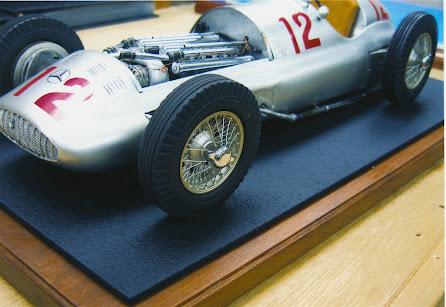
4 minute read
Model cars in Steyning
Model Cars made in Steyning
To drive a winning racing car was a rare ambition and to own a highly detailed scale model of one was to have a rare prize in itself. Living in Steyning, Rex Hays was an engineer who had apprenticed in a bus and truck factory before working for MG cars at the famous Brooklands racing circuit.
Advertisement
Rex Hays had from the age of eleven in 1921 been scratch-building his exquisite intricate models of racing cars and what we now call classic cars. He built them in different scales: 1:20, 1:12, and 1:10 and his models had opening doors, bonnets and boots with the finest of engine detail that seemed miraculous to replicate in miniature. With skills similar to those of a watchmaker, Rex Hays’ models were so prized that some were commissioned and presented as trophies drivers in major races. One model, the E.R.C. Club Trophy consisted of a replica of an E.R.A. car exhibited with its bonnet removed to show the four thousand metal parts in its engine construction. This model is now on display at the Steering Wheel Club in London. Car manufacturers, transport museums, Formula 1 constructors and royal families from across the world commissioned Rex Hays. For King Faisal, Rex built a model of a 1929 Mercedes.
So notable was the work of Rex Hays that in 1952 the Duke Of Edinburgh was asked during the planning of the Model Engineer Exhibition what he would like to see there. He requested a work by Rex Hays. Rex arrived at the show bringing his model in two trucks. He had surpassed himself with this design, which was a four hundred foot long slot-racing Grand Prix track. The electric model cars raced between authentic-looking model crowd stands complete with advertising boards, in which the spaces had been sold in advance to real companies. The exhibit proved extremely popular with the Duke, the organisers, visitors and the sixty thousand pupils at the later held Schoolboys’ Exhibition. as a present for the young Prince Charles who was accompanying the Queen to the Jaguar works at Coventry. He made it with the finest detail that included genuine green upholstery and authentic dashboard material used in the real car. Rex Hays would study a car and draw up his own blueprints for a model, as he knew the manufacturer’s blueprints never completely matched the finished version of an actual car.
The bodywork for Rex Hays’ models was wood, a French Lime that was meticulously chiselled and scalpel-shaved to the millimetre. He insisted that, “The complicated and subtle contours of a modern sports-racing car can be reproduced better by carving than in any other way.”
Rex Hays didn’t believe in metal bodywork, calling it “phoney realism,” if a modeller wasn’t prepared to use the exact mineral content as used in the original car. A model was brushed with two-coats of Shellac and when dry was sandpapered. The process was repeated until the wood was indistinguishable from metal. The model was then painted and then sprayed with a minimum of six coats of cellulose. Rex Hays photographed each intricately detailed miniature upon a modelled road surface with a replica house brick wall in the background. The photographs of the model car were compared to photographs of the real vehicle. He would only consider a model finished if people couldn’t tell which was the model and which was the actual car.
Model Cars made in Steyning
In 1957, for possibly his finest work, Rex Hays visited the London Science Museum to study its 1894 Panhard Et Lavassor. It was Britain’s first petrol engine car and consisted of just seats behind an engine, with no bodywork and large, gun-carriage style wheels. Rex Hays photographed, measured and sketched the car, filling fifty-six pages of a notebook. At his Steyning home he then drew up blueprints and spent five weeks constructing the model. It was mounted on a base and sealed in a glass presentation case. In March 1957 it was given to the Queen during a visit to mark the Royal Automobile Club’s diamond jubilee. In 1958, Macgibbon and Kee published Rex Hays’ drawings in ‘Tribute By Trophy’. Rex Hays also wrote ‘Motor Modelling’ published by Arco and ‘Racing Cars In Miniature’ published by Percival. These books still inspire model makers to scratch build model cars today. On the 11th of June 2005, Rex Hays’ 1938 model of the Mercedes-Benz W163 racing car was auctioned at Christie’s. The model featured metal and brass parts to detail the suspension, steering, twin-supercharged engine, wire-spoke wheels with knock-off hub-nuts; chrome-plated inlet manifolds and exhaust pipes. The model was eighteen inches in size and despite showing its age, was sold with its drawings, related correspondence and two volumes of ‘Motor Modelling’ for £1,410.
Judy Upton
British Pathé News CMA models Motor city garage Motorsport magazine Christie’s Sports Cars Illustrated 1957



